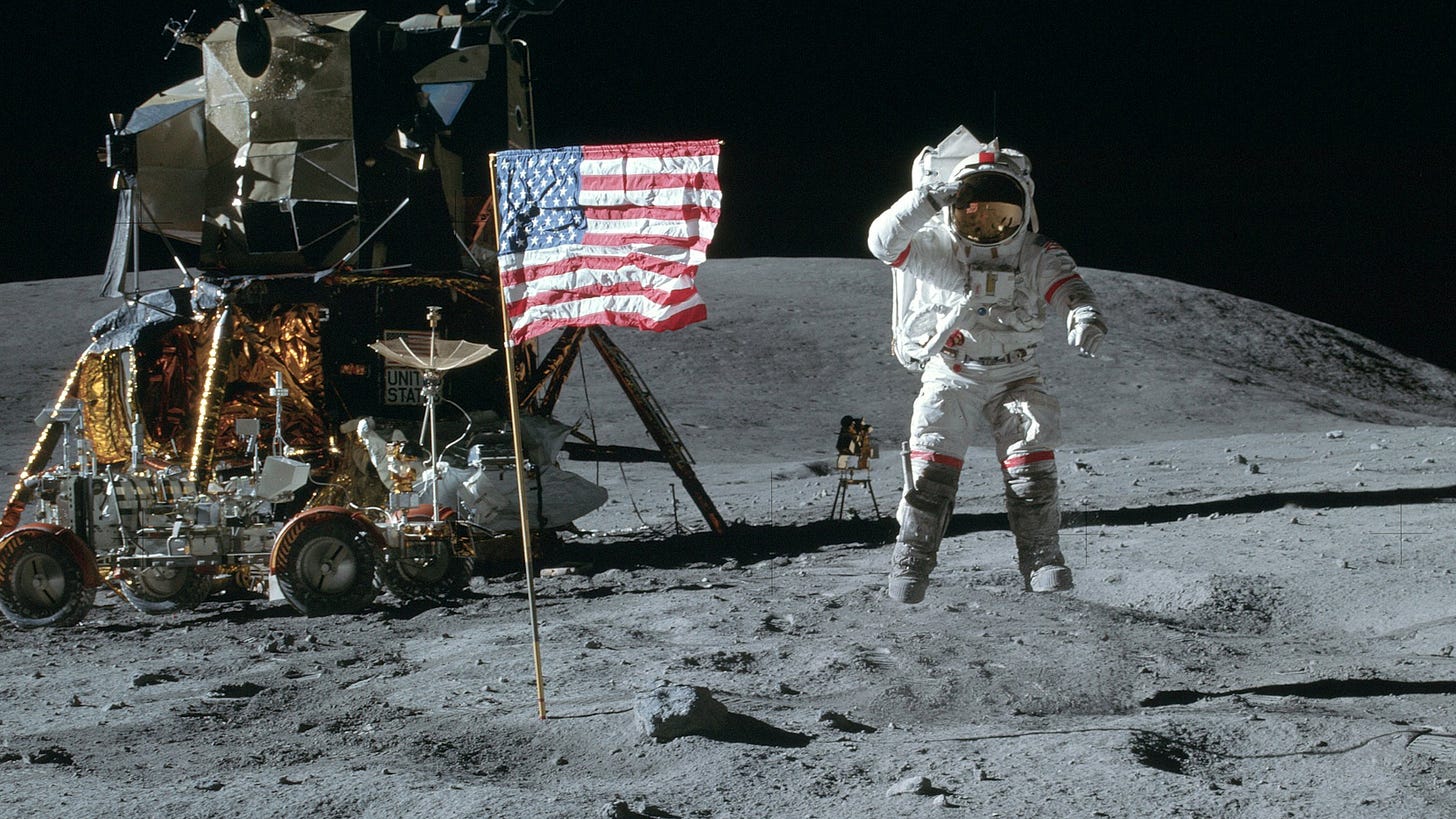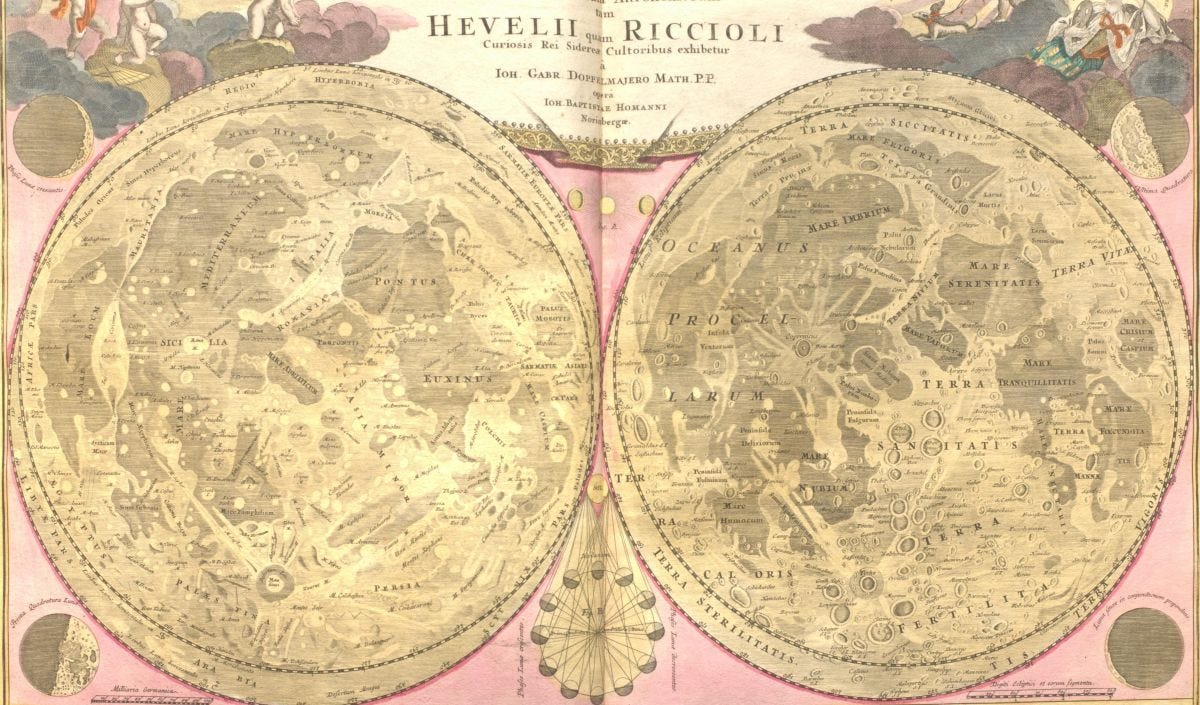Welcome to Thursday Things! Happy Moon Landing Day! If you enjoy this edition, please click the heart icon in the header or at the end of the post to let me know.
Moonsylvania! Image: NASA
This week’s edition of Thursday Things coincides with the 54th anniversary of the Apollo 11 Moon landing, when U.S. astronauts Neil Armstrong and Buzz Aldrin became the first and second human beings respectively to walk on the Moon, July 20, 1969.
True Moon Fact: In all of human history, only Americans have walked on the Moon! That may soon change, as other countries are still trying to do what the USA did 54 years ago with slide rulers. So I think there is still time to declare the Moon a state and call it Moonsylvania.
Mainly because I just like saying Moonsylvania.
In commemoration the historic Apollo 11 landing, here is a roundup of interesting Moon and Apollo 11-related items!
1969 Moon Landing: The basic story of Apollo 11, from History:
On July 20, 1969, American astronauts Neil Armstrong (1930-2012) and Edwin "Buzz" Aldrin (1930-) became the first humans ever to land on the moon. About six-and-a-half hours later, Armstrong became the first person to walk on the moon. As he took his first step, Armstrong famously said, "That's one small step for man, one giant leap for mankind." The Apollo 11 mission occurred eight years after President John F. Kennedy (1917-1963) announced a national goal of landing a man on the moon by the end of the 1960s. Apollo 17, the final manned moon mission, took place in 1972.
The First Moon Landing Hinged On A Single Word To Save It From Disaster: How Jack Garman at Mission Control saved the Apollo 11 landing by doing his homework ahead of time:
A few years ago, a man named Jack Garman passed away. You might not have heard of him, but he had a pivotal role to play in the Apollo 11 lunar landing. And it culminated in a single word that meant the landing could go ahead.
Back in 1969, John “Jack” Garman was working at NASA’s Mission Control Center at the Johnson Space Center in Houston, Texas. He was a computer engineer, involved in making sure the computer that ran the spacecraft worked as intended.
This computer was called the Apollo Guidance Computer (AGC). It was used by the astronauts to navigate and control the spacecraft, using a rudimentary number display and keyboard called a DSKY. They would input controls on this and the spacecraft would respond.
But during the landing attempt on July 20, with Neil Armstrong and Buzz Aldrin on board the lunar lander, something went wrong. An error mode flashed up on the AGC, called a 1202 alarm, as they were descending to the surface. For a few seconds, no one knew what to do, putting the mission in jeopardy…
You’ll never believe what happened next!
Apollo 11: This tool placed on the Moon by Neil Armstrong, Buzz Aldrin still works: The astronauts brought back moon rocks. But they also left a few things behind on the Moon, including this important scientific tool:
Exactly 54 years ago, on July 20, 1969, Apollo 11 astronaut Neil Armstrong stepped onto the lunar surface—the first human to ever walk on the Moon. Shortly after, his colleague Buzz Aldrin joined him. When they landed on the Moon all those years ago, the two astronauts placed a tool on the Moon that is still working today.
The “tool” in question is the laser ranging retroreflector (LRRR). It is a “retroreflector array” built on a folding support structure for aiming and aligning the array towards Earth. It was built of cubes of fused silica. Laser-ranging beams sent from Earth to the Moon are reflected back by LRR, which will help scientists here make precise measurements of the distance between the bodies.
We’ve been shooting lasers at the Moon ever since. Just hope the Moon doesn’t start shooting back…
"We go into space because whatever mankind must undertake, free men must fully share... I believe that this Nation should commit itself to achieving the goal before this decade is out, of landing a man on the Moon and returning him safely to Earth. No single space project in this period will be more exciting, or more impressive to mankind, or more important for the long-range exploration of space, and none will be so difficult or expensive to accomplish."
— President John F. Kennedy
Filmmaker To Build Memorial Commemorating 1969 Apollo 11 Mission In Wyoming: Earlier this year, Wyoming officially designated July 20 as Moon Landing Day, becoming the first state to do so. It’s a great idea and I’m surprised no one thought of it before.
Anyway, this act celebrating the moon mission has motivated California-based filmmaker Steven Barber to take up a mission of his own in Wyoming:
California-based filmmaker Steven Barber agrees, which is why he said he’s on a mission to build an Apollo 11 monument in Wyoming.
Having grown up a junkie for everything space-related and holding American astronauts as his heroes, Barber said he loves Wyoming for being the first state to recognize Moon Landing Day.
“If you can put a man on the moon, why can’t you build a monument to the first men on the moon?” he asked Cowboy State Daily on Tuesday.
That’s a perfectly reasonable question.
Celebrate 400 years of moon maps for Apollo 11's anniversary (gallery): Here at Thursday Things we love maps. So I couldn’t pass up this gallery of 400 years worth of maps of the Moon!
We've been mapping the moon in detail ever since telescopes were invented.
Humans last walked on the moon during the Apollo program, between 1969 and 1972. (And the 54th anniversary of the epic Apollo 11 landing is July 20.) NASA plans to return people to the lunar surface during the Artemis program as soon as 2025 or 2026. Getting spacecraft and people safely to the moon, however, requires high-definition imagery.
The U.S. Library of Congress gave Space.com permission to publish photos of a few of the moon maps in its possession, some of which are 400 years old. Below you can see sketches from people like Galileo, early moon photographs and pioneering spacecraft images.
Tabula Selenographica in qua Lunarium Macularum exacta Descriptio. Johann Baptist Homann (1748) Image: Library of Congress via Space.com
Thank you for reading!
Please click the hearts, leave a comment, and use the share feature to send this issue to a friend who might enjoy it. See you next Thursday!




